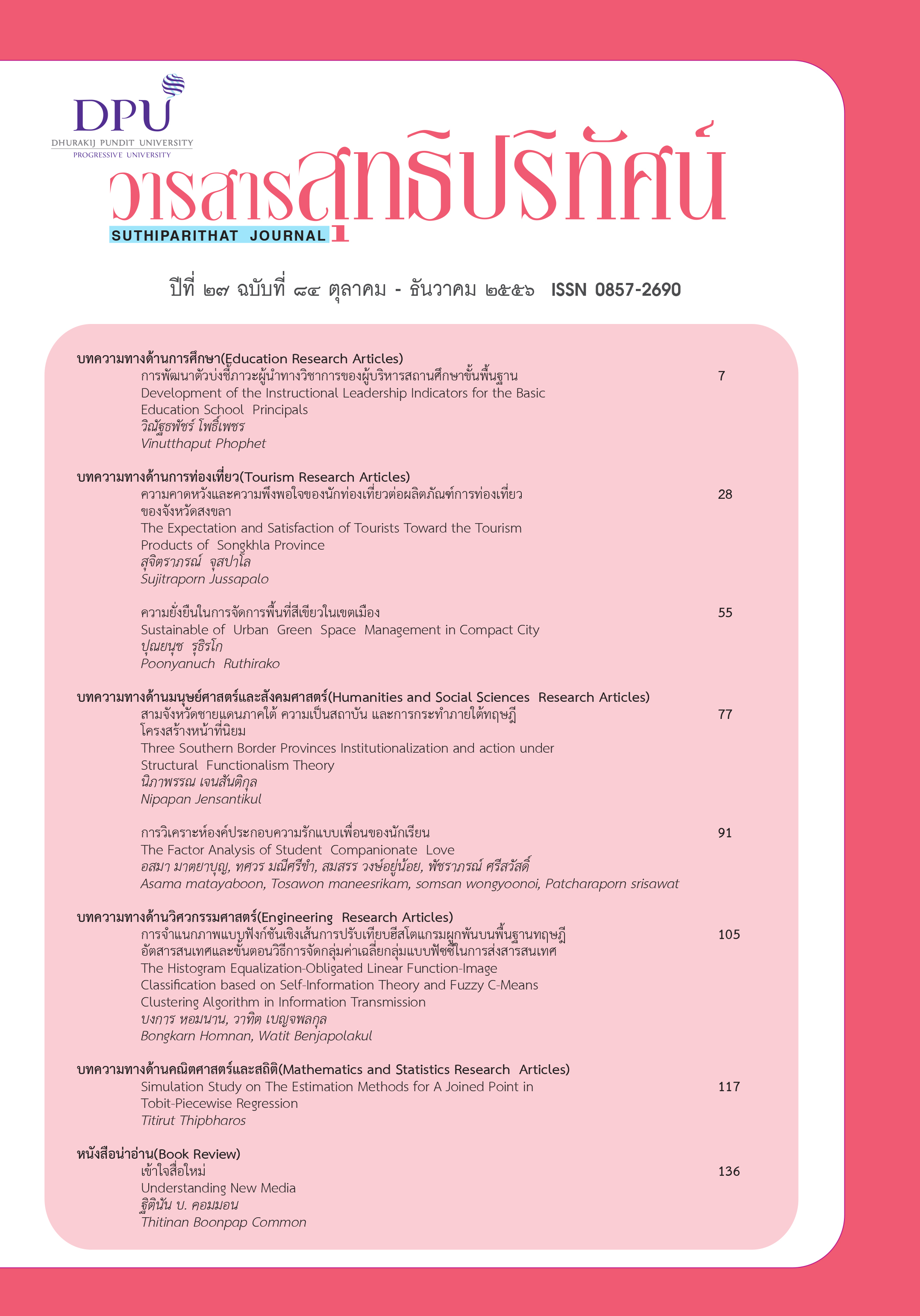ความยั่งยืนในการจัดการพื้นที่สีเขียวในเขตเมือง
คำสำคัญ:
ความยั่งยืน, พื้นที่สีเขียว, การจัดการเมืองบทคัดย่อ
ปัจจุบันเมืองมีการขยายตัวอย่างรวดเร็วเพื่อสนองตอบการขยายตัวทางด้านเศรษฐกิจ ประกอบกับจำนวนประชากรที่เพิ่มสูงขึ้นทำให้มีการอพยพย้ายถิ่นเข้ามาอาศัยอยู่ในเมืองส่งผลให้มีความต้องการใช้ที่ดินเพื่อการก่อสร้างมากขึ้น ก่อให้เกิดที่ว่่างในเมืองลดน้อยลง และยังส่งผลทำให้พื้นที่สีเขียวในเขตเมืองลดลงไปด้วย ฉะนั้นการดำเนินการเพื่อจัดการพื้นที่สีเขียวจึงมีความสำคัญยิ่ง เพราะนอกจากจะส่งผลดีต่อสภาพแวดล้อมเมืองแล้วยังส่งผลดีต่อสิ่งแวดล้อมของเมือง และที่สำคัญไปกว่านั้นคือช่วยให้คนเมืองมีสถานที่พักผ่อนหย่อนใจออกกำลังกาย พบปะพูดคุย และช่วยเพิ่มคุณภาพชีวิตของคนเมืองอีกด้วย
การจัดการพื้นที่สีเขียวในเขตเมืองอย่างยั่งยืนขึ้นอยู่กับบุคคลต่างๆ ที่มีส่วนเกี่ยวข้องทั้งในระดับท้องถิ่น ระดับชาติและระดับนานาชาติ ได้แก่ นักการเมือง ข้าราชการ เอกชนและชุมชน ส่วนการดำเนินการควรดำเนินการทั้ง 3 ระดับได้แก่ ระดับปฏิบัติ ระดับกลยุทธ์และระดับนโยบาย ซึ่งความสำเร็จในการวางแผนและจัดการพื้นที่สีเขียวนั้นขึ้นอยู่กับปัจจัยต่างๆ ได้แก่ การใช้พื้นที่สีเขียวร่วมกัน การปรับ การใช้พื้นที่เมื่อเวลาผ่านไป การมีส่วนร่วมอย่างจริงจังของผู้บริหารเมือง การมีส่วนร่วมของชุมชน ความเกี่ยวข้องกันระหว่างกลุ่มที่มีหน้าที่ในการรับผิดชอบ การออกกฎหมายสนับสนุนความสัมพันธ์ที่ดีระหว่างท้องถิ่นและนักวางแผน การบำรุงรักษา นโยบายสาธารณะและโครงสร้างขององค์กร
เอกสารอ้างอิง
จิรากรณ์ คชเสนี. (2549). มนุษย์กับสิ่งแวดล้อม (พิมพ์ครั้งที่ 4). กรุงเทพฯ: จุฬาลงกรณ์มหาวิทยาลัย.
ศิริวรรณ ศิลาพัชรนันท์ และคณะ. (2549). โครงการจัดทำแผนการจัดการพื้นที่สีเขียวที่สมบูรณ์ทางด้านระบบนิเวศอย่างยั่งยืน. ใน สาระศาสตร์ครั้งที่ 10 พ.ศ. 2549: สถานการณ์สานสาระ. กรุงเทพฯ: จุฬาลงกรณ์มหาวิทยาลัย.
สำนักงานคณะกรรมการพัฒนาเศรษฐกิจและสังคมแห่งชาติ สำนักนายกรัฐมนตรี. (ม.ป.ป.). แผนพัฒนาเศรษฐกิจและสังคมแห่งชาติฉบับที่ 8 พ.ศ. 2540-2544. กรุงเทพฯ: ผู้แต่ง.
สำนักงานคณะกรรมการพัฒนาเศรษฐกิจและสังคมแห่งชาติ. (ม.ป.ป.). แผนพัฒนาเศรษฐกิจและสังคมแห่งชาติฉบับที่ 9 พ.ศ. 2545-2549. กรุงเทพฯ: ผู้แต่ง.
สำนักงานนโยบายและแผนทรัพยากรธรรมชาติและสิ่งแวดล้อม. (2547). รายงานฉบับสมบูรณ์มาตรการในการเพิ่มและการจัดการพื้นที่สีเขียวในเขตชุมชนอย่างยั่งยืน. กรุงเทพฯ: มหาวิทยาลัยเกษตรศาสตร์
สำนักงานนโยบายและแผนทรัพยากรธรรมชาติและสิ่งแวดล้อม. (2548 ก). คู่มือการพัฒนาพื้นที่สีเขียว. เชียงใหม่: โทนคัลเลอร์.
สำนักงานนโยบายและแผนทรัพยากรธรรมชาติและสิ่งแวดล้อม. (2548 ข). รายงานฉบับสมบูรณ์โครงการนำร่องแนวคิดใหม่สู่การเป็นเมอืงสีเขียว: เขตเทศบาลนครเชียงใหม่และพื้นที่โดยรอบ. กรุงเทพฯ: ผู้แต่ง.
สำนักงานนโยบายและแผนทรัพยากรธรรมชาติและสิ่งแวดล้อม. (2549). โครงการจัดทำแผนการจัดการพื้นที่สีเขียวที่สมบูรณ์ทางด้านระบบนิเวศอย่างยั่งยืน. กรุงเทพฯ: ศูนย์ถ่ายอินเตอร์ จำกัด.
สุกาญจน์ รัตนเลิศนุสรณ์. (2546). หลักการจัดการสิ่งแวดล้อม. กรุงเทพฯ: ส.ส.ท.
อนิศรา อ่อนบุญญะ. (2549). แนวทางการจัดการพื้นที่สีเขียว บางกระเจ้า จังหวัดสมุทรปราการ (วิทยานิพนธ์ปริญญามหาบัณฑิต). กรุงเทพฯ: มหาวิทยาลัยเกษตรศาสตร์.
อาชัญญา รัตนอุบล และคณะ. (2548). การจัดการเรียนรู้ของแหล่งการเรียนรู้ตลอดชีวิต: สวนสาธารณะ (รายงานการวิจัย). กรุงเทพฯ: วี.ที.ซี. คอมมิวนิเคชั่น.
Barthel, S., et al. (2005). History and local management of a biodiversity-rich, urban cultural land-scape. Ecology and Society, 10. Retrieved September 8, 2009, from http://www.ecologyandsociety.org/vol10/iss2/art10/S
Beatley, T. (2000). Green Urbanism: Learning from European Cities. Canada: Island Press.
Bixler, R. D., & Floyd, M. F. (1997). Nature is scary, disgusting and uncomfortable. Environment and Behaviour, 29, 443-467.
Bolitzer, B., & Netusil ,N. R. (2000). The Impact of open spaces on property values in Portland, Oregon. J Environ Manag, 59: 185–193.
Bonsignore, R. E. (2003). The diversity of green spaces. Design Center for American urban Landscape. Design Brief, number 2/August. Design Centre for the American Urban Landscape, University of Minnesota, Minneapolis. Retrieved September 7, 2009, from http://www.designcenter.umn.edu/reference_ctr/publications/pdfs/db2.pdf
Brennan, S., & Withgott, J. (2005). Environmental: The Science behind the stories. San Francisco: Benjamin Cummings.
CABE Space. (2004). The Value of public space: how high quality parks and public spaces create economic, social and environmental value. London.CABE: Space.
Chiesura, A. (2004). The Role of urban parks for the sustainable city. Landscape and Urban Planning, 68, 129–138.
Fuller, R. A., & Gaston, K. J. (2009). The scaling of green space coverage in European cities. Biology letters, 5, 352-355.
Grahn, P., & Stigsdotter, U. A. (2003). Landscape planning and stress. Urban Forestry & Urban Greening, 2, 1–18.
Honjo, T., & Takakura, T. (2000). Simulation of the influence of urban green space areas with various scales and allocation. Journal of Agriculture Meteorology, 56, 233-260.
Hu, Z. L., et al. (2007). Analysis of urban expansion and driving forces in xuzhou city based on remote sensing. Journal of China University of Mining & Technology, 17(20), 267-271.
Huang, D., Lu, C., & Wang, G. (2009). Integrated management of urban green space: The Case in Guangzhou China. In 45th ISOCARP Congress 2009. 18-22 October 2009. Portogal: Porto.
Jim, C. Y., & Chen, S. W. (2003). Comprehensive green space planning based on landscape ecology principles in compact Nanjing city, China. Landscape and Urban Planning, 65, 95–116.
Jorgensen, A., Hitchmough, J., & Dunnett, N. (2007). Woodland as a setting for housing-appreciation and fear and the contribution to residential satisfaction and place identity in Warrington New Town, UK. Landscape and Urban Planning, 79, 273-287.
Jun, W. X. (2009). Analysis of problems in urban green space system planning in China. Journal of Forestry Research, 1, 79-82.
Kuchelmeister, G. (1998). Urban green for local needs –improving quality of life through multipurpose urban forestry in developing countries. In Proceedings of the first international conference on quality of life in cities, 4-6 March 1998. Singapore, 1, 181-191.
Kuo, F. E., Baciaco, M., & Sullivan, W. C. (1998). Transforming inner city landscapes : Trees, sense of place and preference. Environment and Behavior, 42, 462-483.
Levent, T. B., & Nijkamp, P. (2009). Planning and Management of Green Spaces in Europe. Urban Planning and Development. 135(1).
Luttik, J. (2000). The value of trees, water and open space as reflected by house prices in the Netherlands. Landscape and Urban Planning, 48, 161–167.
Ma, Y., & Xu, R. (2010). Remote sensing monitoring and driving force analysis of urban expansion in uangzhou City, China. Habitat International, 34, 228-235.
Manlun, Y. (2003). Suitability analysis of urban green space system based on GIS (master’s thesis). Netherland: International Institute for Geo-information Science and Earth Observation.
Mugenyi, A. (2002). Use of green space in Zaqmqlek, Cairo. Urban Planning and Land Administration. Enshede, ITC, 30.
Qureshi, S., Breuste, J. H., & Lindley, S. J. (2010). Green space functionality along an urban gradient in Karachi, Pakistan: A Socio-Ecological Study. Human Ecology 38(2), 283-294.
Randrup, T. B., & Persson, B. (2009). Public green spaces in Nordic countries: Development of a new strategic management regime. Urban Forestry & Urban greening, 8, 31-40.
Sampson, N., & Scholes, R. J. (2000). Additional human-induced activities. In Watson, B., Noble, I., Bolin, B., Ravindranath, N. R., Verardo, D. J., & Dokken, D. J. (Eds.), Land Use, Land-use Change and Forestry. A Special report of the Intergovernmental Panel on Climate Change (IPCC). Cambridge, UK: Cambridge University Press,.
Schioppa, C. P., et al. (2009). Fringe parks, green spaces and urban forestry in
Milano (Italy): state of the art and future development. In XIII World Forestry Congress. Buenos Aires, Argentina, 18-23 October 2009.
Smyrl, M. (2004). It’s too easy being green (space): A Study of the South County Greenspace Program. Retrieved March 7, 2010, from http://envstudies.brown.edu/theses/MollySmyrlThesis.pdf
Sukopp, H., Numata, M., & Huber, A. (Eds.). (1995). Urban ecology as the basis for urban planning. The Netherlands: SPB Academic publishing.
Takahashi, K. (2008). Greenspace Depletion in Tokyo, Japan (master’s thesis). Ohio: Ohio University.
UNDP (United Nations Development Programme). (2000). United Nations Environment Programme, World Bank, and World Resources Institute. Amsterdam: Elsevier Science,.
UNFPA (United Nations Population Fund). (2007). State of world population 2007. UNFPA.
United Nations. (2004). World urbanization prospects: The 2003 revision. New York: United Nations.
Wu, R. (1999). The classification of green space system. Chinese Horticulture, 15(6), 26-32.
ดาวน์โหลด
เผยแพร่แล้ว
รูปแบบการอ้างอิง
ฉบับ
ประเภทบทความ
สัญญาอนุญาต
เนื้อหาและข้อมูลในบทความที่ลงตีพิมพ์ในวารสารสุทธิปริทัศน์ ถือเป็นข้อคิดเห็นและความรับผิดชอบของผู้เขียนบทความโดยตรงซึ่งกองบรรณาธิการวารสาร ไม่จำเป็นต้องเห็นด้วย หรือร่วมรับผิดชอบใด ๆ
บทความ ข้อมูล เนื้อหา รูปภาพ ฯลฯ ที่ได้รับการตีพิมพ์ในวารสารสุทธิปริทัศน์ ถือเป็นลิขสิทธิ์ของวารสารสุทธิปริทัศน์หากบุคคลหรือหน่วยงานใดต้องการนำทั้งหมดหรือส่วนหนึ่งส่วนใดไปเผยแพร่ต่อหรือเพื่อกระทำการใด ๆ จะต้องได้รับอนุญาตเป็นลายลักษณ์อักษรจากวารสารสุทธิปริทัศน์ก่อนเท่านั้น







